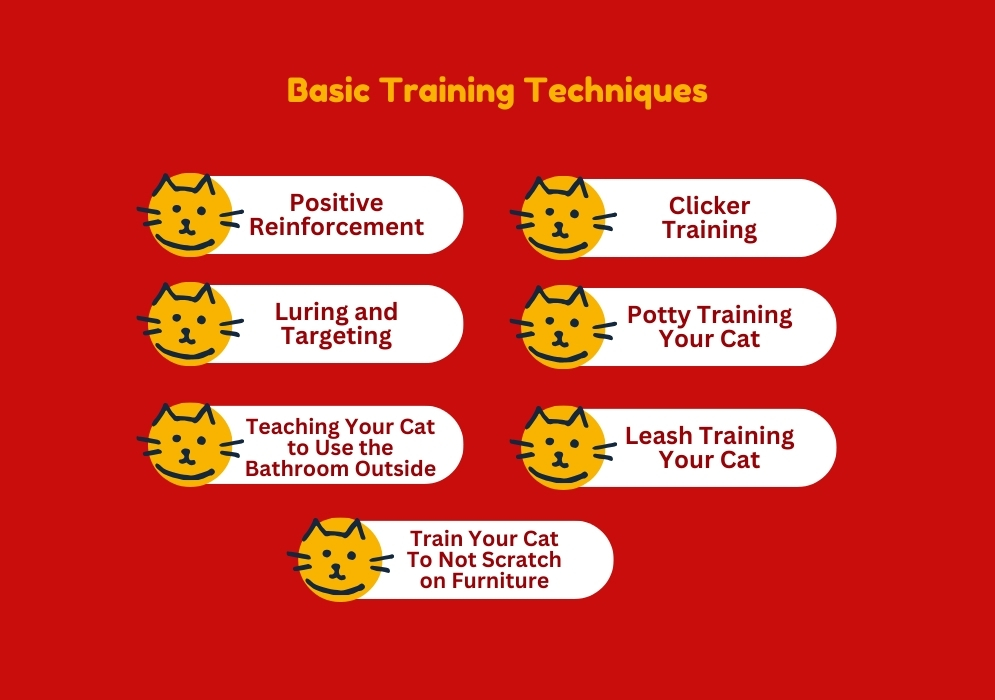How to Train a Cat: Expert Advice and Tips for First-time Cat Parents


Cats are often perceived as independent and aloof, making some pet parents believe that training them is an impossible task. However, it can be done with a lot of patience, consistency, and effort. In this comprehensive guide, we’ll explore the benefits of training your cat and give you tips on how to train a cat. Read on to know more.
What Are the Benefits of Training Your Cat?

Contrary to popular belief, training your cat can bring numerous benefits to both you and your furry companion. Here’s why you should consider investing time and effort into training your cat:
Improved Behavior
Training helps to curb unwanted behaviors, such as scratching furniture, excessive meowing, or jumping on counters. You can create a harmonious living environment by teaching your cat appropriate behaviors.
Enhanced Safety
Training can teach your cat crucial safety skills, like coming when called or walking on a leash. This can be especially important in emergency situations or when navigating outdoor environments.
Stronger Bond
The process of training strengthens the bond between you and your cat. It provides an opportunity for positive reinforcement, mutual understanding, and quality time spent together.
Increased Confidence
Successful training can boost your cat’s confidence and self-assurance, making them more adaptable to new environments and situations.
Mental Stimulation
Training exercises your cat’s cognitive abilities, providing mental stimulation and preventing boredom, which can lead to undesirable behaviors.
Understanding Your Cat’s Behavior and Instincts

Before diving into the training techniques, it’s essential to understand your cat’s unique behavior and instincts. Cats are natural predators, and their behaviors are often driven by their innate hunting and survival instincts. Recognizing these tendencies can help you tailor your training approach to your cat’s needs.
Some key aspects of feline behavior and instincts to keep in mind include:
- Curiosity and Exploration: Cats are naturally curious creatures, constantly exploring their environment. Channeling this curiosity can be a powerful tool in your training arsenal.
- Prey Drive: Cats have a strong prey drive, which can manifest in behaviors like pouncing, chasing, and stalking. Incorporating these instincts into your training can make it more engaging for your cat.
- Territoriality: Cats are very territorial and may exhibit behaviors like scratching, marking, or guarding their space. Understanding this can help you address these issues during training.
- Sensitivity to Sensory Inputs: Cats have heightened senses, such as sight, hearing, and smell. Being mindful of these sensitivities can help you create a more positive training environment.
By understanding your cat’s unique behavioral traits and instincts, you’ll be better equipped to tailor your training approach and achieve successful results.
How To Train A Cat: Basic Training Techniques

Now that you have a solid understanding of your cat’s behavior and instincts, let’s dive into the basic training techniques that can help you create a well-behaved and happy feline friend.
Positive Reinforcement
Positive reinforcement is the cornerstone of effective cat training. This approach involves rewarding your cat with treats, praise, or affection whenever they exhibit the desired behavior. By associating the desired behavior with a positive outcome, your cat will likely repeat it.
Here are some tips for using positive reinforcement effectively:
- Choose high-value treats your cat truly enjoys, such as small pieces of cooked chicken or tuna.
- Deliver the reward immediately after the desired behavior to reinforce the connection.
- Vary the rewards to keep your cat engaged and motivated.
- Use consistent verbal cues, like “good job” or “well done,” to reinforce the behavior.
Clicker Training
Clicker training is a powerful technique that utilizes a small handheld device that makes a distinct clicking sound. The clicker marks the exact moment your cat performs the desired behavior, allowing you to communicate what you want them to do precisely.
To get started with clicker training:
- Introduce the clicker: Let your cat become familiar with the sound of the clicker by clicking it and immediately providing a treat.
- Associate the click with the reward: Consistently click and treat until your cat understands that the click means a reward is coming.
- Shape behaviors: Use the clicker to mark and reward successive approximations of the desired behavior, gradually shaping your cat’s actions.
Luring and Targeting
Luring and targeting are techniques that use your cat’s natural curiosity and desire to follow a target, such as a treat or a pointer, to guide their behavior.
- Luring: Hold a treat near your cat’s nose and slowly move it to guide them into the desired position or action, such as sitting or coming to you.
- Targeting: Use your finger or a target stick to touch your cat’s nose, then reward them when they touch the target. This can be used to teach a variety of behaviors, like walking on a leash or stepping into a carrier.
Potty Training Your Cat
One of the most important training tasks for any cat owner is potty training. Proper litter box training can prevent unwanted messes and create a harmonious living environment.
Here’s how to potty train your cat:
- Choose the right litter box: Select a box that is large enough for your cat to move around in comfortably. Avoid covered litter boxes, as some cats prefer an open environment.
- Provide multiple litter boxes: Place litter boxes in various locations throughout your home, especially in quiet, easily accessible areas.
- Use the right litter: Experiment with different litter types to find the one your cat prefers. Many cats prefer soft, fine-grained litters.
- Establish a routine: Encourage your cat to use the litter box by taking them to the box regularly, such as after meals, naps, or playtime.
- Reward and praise: When your cat uses the litter box, provide immediate positive reinforcement with treats and verbal praise.
Teaching Your Cat to Use the Bathroom Outside
If you’d like to train your cat to use the bathroom outside, introduce them to the outdoors in a controlled and safe environment. Here’s how:
- Slowly introduce your cat to the outdoors, taking them on short, supervised trips to a designated potty area.
- Observe your cat’s natural bathroom habits and take them to the designated area when you notice them exhibiting those behaviors.
- Reward and praise your cat when they use the outdoor potty area.
- Gradually increase the time and frequency of outdoor potty training sessions.
Remember, it’s essential to be patient and consistent throughout the potty training process. With time and positive reinforcement, your cat will learn where and how to properly relieve themselves.
Leash Training Your Cat
Leash training your cat can provide numerous benefits, such as increased safety, the ability to take them on outdoor adventures, and stronger bonding. Here’s how to leash train your cat:
- Start with a comfortable, well-fitting harness: Choose a leash that allows your cat to move freely without feeling restricted.
- Introduce the leash slowly: Let your cat sniff and get used to the leash before attempting to put it on. Reward them with treats and praise during this process.
- Practice indoor walking: Once your cat is used to the harness, start practicing short indoor walking sessions, rewarding them for remaining calm and walking with you.
- Transition to the outdoors: Slowly introduce your cat to the outdoors, starting in a quiet, enclosed area like a backyard or patio. Gradually increase the duration and complexity of your outdoor walks.
Leash training takes time and patience. So stick to a regular training schedule and celebrate your cat’s progress, no matter how small.
Train Your Cat To Not Scratch on Furniture
Scratching is a natural and essential behavior for cats, but it can be frustrating when they target your furniture. Here’s how to prevent your cat from scratching your belongings:
- Provide appropriate scratching posts: Place a variety of scratching surfaces, such as vertical posts, horizontal pads, or angled scratchers, in various locations throughout your home.
- Use deterrents: Apply citrus-based or double-sided sticky tape to areas you don’t want your cat to scratch, as they dislike these textures and scents.
- Redirect the behavior: When you catch your cat scratching furniture, gently interrupt them and redirect their attention to an approved scratching surface, rewarding them when they use it.
- Consider pheromone diffusers: Calming pheromone diffusers can help reduce your cat’s stress and anxiety, which can contribute to unwanted scratching behaviors.
By providing your cat with appropriate scratching outlets and using positive reinforcement, you can curb unwanted scratching and protect your furniture.
Common Mistakes to Avoid When Training Your Cat

While training your cat can be a rewarding experience, there are some common mistakes to avoid:
- Inconsistency: Inconsistent training methods or expectations can confuse your cat and hinder their progress.
- Punishment: Avoid using punishment or negative reinforcement, as this can damage the bond between you and your cat and lead to fear-based behaviors.
- Overtraining: Cats have shorter attention spans than dogs, so keep training sessions brief and engaging to prevent boredom or frustration.
- Ignoring your cat’s signals: Pay attention to your cat’s body language and behavioral cues, and adjust your training approach accordingly.
- Lack of patience: Cats learn at their own pace, so be patient and celebrate small victories along the way.
By avoiding these common pitfalls and focusing on positive reinforcement, you’ll be well on your way to training a happy and well-behaved feline friend.
Remember, every cat is different, so be prepared to adjust your training approach to suit your cat’s individual needs and preferences. With consistency, patience, and a little creativity, you can transform your cat into a well-behaved and happy member of the family.









Leave A Comment